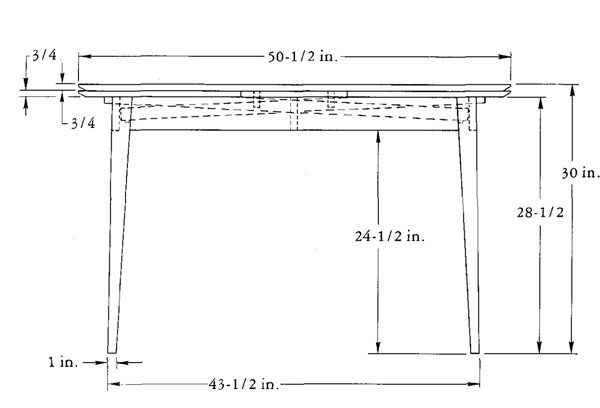Designing for Dining
Dutch pull-out extends table for guests
Synopsis: Of all the types of extension dining tables, Tage Frid prefers the “Dutch pull-out” dining table because it is both simple and fast to make. The tabletop consists of two pieces of plywood, one mounted right above the other on the base. The lower piece is cut into three sections — two are leaves, and the third is a fixed center piece. He made the table shown in the article in four or five days, including veneering and edging it. He discusses dimension issues in designing a dining table, curved vs. rectangular tables, and includes step-by-step instructions on making one like the one in the photos.
There are several different systems to choose from when making an extension dining table. Some you can purchase ready-made; they are usually quite expensive. Of the ones you can make yourself, I prefer the “Dutch pull-out” dining table. It is both simple and fast to make.
The tabletop consists of two pieces of plywood, both the same size, one mounted right above the other on the base. The lower piece is cut into three sections—two of them are the leaves, and the third is a fixed center piece. The top rests on the center piece and the leaves and is held there by two vertical dowels sitting loosely in guide holes. Thus it is free to move up and down but not from side to side. The leaves are mounted on long tapered slides that allow them to be pulled out from the ends. The slides travel in grooves in the end aprons and in a supporting rail across the center of the table base. As a leaf is extended, the taper makes it rise slowly throughout its travel to the level of the top. As the leaf rises, so does the top, until the leaf is fully extended and clear of the top. Then the top drops down again, flush with the leaf. Before the leaf can be pushed back in the top has to be lifted high enough to clear, then the top settles back down onto the center piece as the leaf travels back to its original position.
I made the table illustrated here 25 years ago, and it took four or five days, including veneering and edging plywood for the top. Once you understand the system, the work is easy and should go very quickly. You’ll have to make four slides and only eight mortise-and-tenon joints. Other than wood for the base and the slides, you need hardwood-veneered plywood, two 3/4-in. dowels and edging for the top.
In addition to being easy to make, the leaves store right inside the table and are easy to pull out, even with the table set. If uninvited guests show up just when the food is on the table and you are ready to sit down, and they apologize for interrupting your meal but hint that they haven’t eaten yet themselves, before you know it they are invited to join you. With most extension systems you would have to clear the table before you could enlarge it. But with the Dutch pull-out you can pull out the leaves without disturbing the setting at all.
There are several important dimensions you must consider when designing a dining table.
More on FineWoodworking.com:
From Fine Woodworking #9
For the full article, download the PDF below:
Fine Woodworking Recommended Products

Estwing Dead-Blow Mallet

Festool DF 500 Q-Set Domino Joiner

Stanley Powerlock 16-ft. tape measure





















Comments
There is quite a bit of text missing on page 3 of his article - page 36 of issue 9. Any way to fix this?
Hi there. I saw your comment and went to look at the article. I don't see where there's missing text in the PDF. Are you referring to text in the body of the article?
Yes. There is a lot of text missing in the body of the article on page 36. There is a lot of white space, at least in the version down loaded on my Mac.
What are you using to view the PDF? Which Mac OS version? I've heard about similar issues elsewhere for some Mac users running Catalina. This is what I see on the bottom half of the page when I open the PDF in Chrome. I blurred the text since it is Member-only content.
It displays correctly in Adobe Reader, too.
Thanks for looking into this, Dave. I opened the pdf in Acrobat Reader and all the text is there.
Ed Neu
Buffalo, MN
Howdy almost neighbor! Excellent news. Thanks for reporting.
Dave
Log in or create an account to post a comment.
Sign up Log in